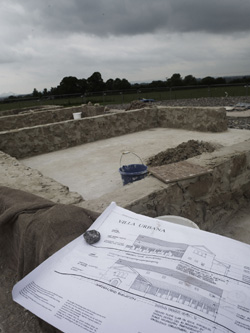Tensar Supports Roman Villa Recreation for Channel 4
The proposal to recreate a Roman Villa/ Bath House on an English Heritage site at Wroxeter, near Shrewsbury, for Channel 4’s January 20, 2011 programme ‘Rome Wasn’t Built in a Day’ , was made possible by constructing it on a reinforced concrete raft foundation over a rock mattress mechanically stabilised with Tensar’s TriAx™ geogrid.

Evans Wolfenden Partnership (EWP) Structural Engineer’s director Graham Wolfenden explains: “English Heritage was adamant that permanent damage should not be made to archeological remains under the soil so that ruled out building traditional foundations or imposing excessive loading. The construction had to be placed directly on to the existing grass and topsoil and we could not have done it without advice from Tensar.”
Due to constraints laid down by English Heritage and the sensitive nature of the sub-soils, restrictions were placed on any form of intrusive investigation. EWP undertook the design of the foundations assuming low bearing pressures (which would be kept off the historical fill material) immediately beneath the concrete raft foundation, so they reduced the pressures at the interface between the rock mattress and original sub-soils.
Photo: Tensar International’s TriAx geogrid was specified for the load-bearing rock mattress under the foundations of Channel 4’s Recreation of a Roman Villa in Wroxeter. The build, in six episodes, starts January 11.
Following discussions between Shropshire County Council – Building Control and EWP, it was agreed that given that the building was classified as a “temporary” structure, it would be acceptable to erect the building off the rock mattress/ concrete foundation taking the above design parameters into account.
A 450 mm thickness of rock mattress consisting of sub-base aggregate, stabilised with TriAx™ geogrid layers, was able to comfortably support the loadings from the new building and concrete floor slab and distribute them so as not to overstress the subsoil layer.
A layer of TriAx™ TX160G geocomposite, consisting of a stiff polymer grid laminated to a geotextile, was first laid over the existing grassed surface. This provided the dual functions of mechanically stabilising the aggregate and also protecting the subsoil by separating fill the particles from the soil. The footprint of the 450mm deep stabilised mattress was extended two metres outside the perimeter of the new slab giving a mattress plan area of 23 metres by 23 metres.
“Without the mechanical stabilisation of the TriAx™, it would be very difficult to say how much extra imported aggregate would have been needed to act as a stable base,” adds Graham. “As well as aiding the project’s sustainability, this ensured that the villa could be speedily and cost effectively recreated as a ‘temporary’ educational feature of the site, and mitigate the possibility of any differential settlement.”
Darlow Smithson Production’s ‘Build a Roman Villa’ challenge was to construct a full size dwelling at Wroxeter, Shropshire, which was once Britain’s fourth largest Roman town; the project was run by Darlow Smithson Productions and documented for a new Channel 4 six part television series. Located on an English Heritage site, the villa will be opened to the public from 19th February, 2011. The design is based on an actual Roman villa found nearby and involved difficult challenges using original Roman building techniques and much artistic work including painting frescos to replicate the Romans’ love of colourful interiors.
“A daunting project, and the modern day six-man team of builders had to figure out much of it for themselves, helped by archaeologist Professor Dai Morgan Evans,” added a Channel 4 spokesperson. “As the build progressed, local volunteers became involved in helping the builders, including girl guides and the Embroiders’ Guild. It’s a real insight into how the Romans built and lived.”
Building work included everything from giant timber frames to tiny mosaics and Roman glass windows. Involved in the build were 36 tonnes of plaster, 200,000 tesserae for the mosaic, 150 tonnes of sandstone bricks faced by hand, 15 tonnes of lime mortar, over 30 tonnes of oak, 1500 hand cut joints in the timber frame and 3,000 handmade clay roof tiles.
Site Owners: English Heritage
Client: Darlow Smithson Productions for Channel 4 Television
Consulting Engineers: Evans Wolfenden Partnership Ltd
Architects: Robert Adam Ltd and Vitruvius
Rome Wasn’t Built in a Day (How to Build a Roman Villa (W/T)) is a Darlow Smithson Production for Channel 4, in six programmes from January 11 2011. It was executive produced by Julian Ware and Tom Brisley. The series was commissioned for Channel 4 by Julia Harrington.
For more information on Tensar mechanical stabilisation technology, TX 160/170 and Tensar TriAx™ please visit http://www.tensar.co.uk and down load brochures.
Ends
Notes to editors:
Tensar International is part of Tensar Corporation, a leading global developer and manufacturer of proprietary, highly engineered, non-traditional site-development solutions for infrastructure end-markets, including transportation, commercial and industrial construction.
Tensar provides its customers with an integrated suite of innovative products, technologies and application expertise for a wide variety of end uses, including high performance roadways, earth retention structures, building foundations and erosion and sediment control.
In 2007, Tensar launched TriAx™ a new geogrid which Tensar believes offers superior performance in multi-directional stiffness and aggregate confinement, which enables better radial load resistance, resulting in a reduction in aggregate base thickness and improved resistance to rutting.
The company also offers a comprehensive design service, technical seminars and on-site support, as part of a range of support services. Tensar International, formerly The Netlon Group, was founded in Blackburn, Lancashire, in 1952.
Tensar International, Cunningham Court, Shadsworth Business Park, Shadsworth, Blackburn BB1 2QX
